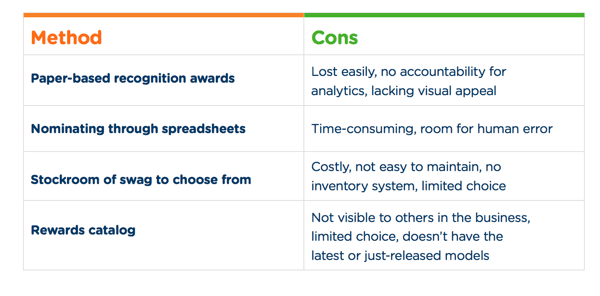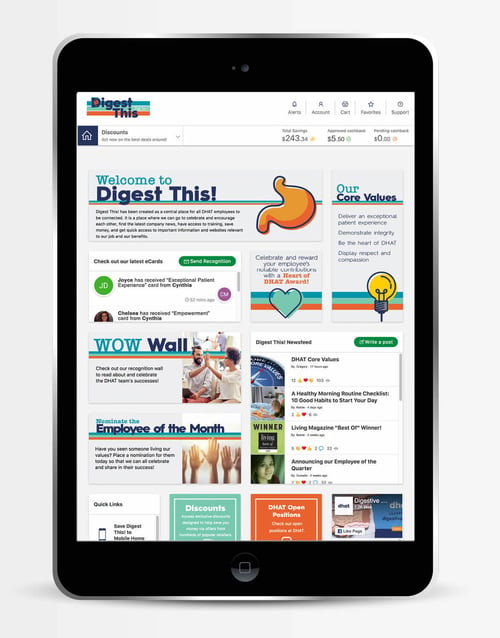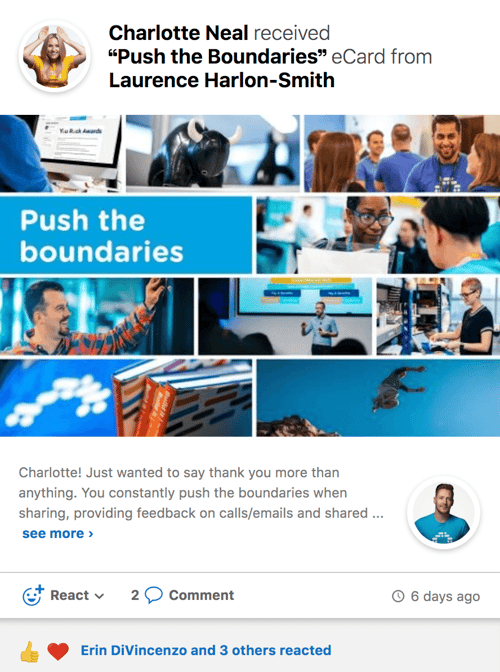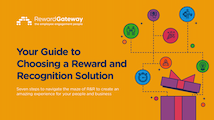6 min read
Employee recognition is essential to transforming your organization. But it’s key to take it a step further, beyond the “thank you.” When employee recognition is strategic and meaningful, it has the power to improve business results, connect your people and improve your company culture.
Here are seven ways to make employee recognition more impactful at your organization:
| 1. Make recognition easy |
| 2. Make reward and recognition immediate |
| 3. Put a spotlight on reward and recognition |
| 4. Make reward and recognition meaningful and exciting |
| 5. Make reward and recognition uniquely yours |
| 6. Invest in a solution your people will use |
| 7. Find a partner, not a vendor |
Step one: Make recognition easy
Reward and recognition (or, as we like to say recognition and reward), must be easy for your people to understand, and for your business to put in place.
Whether you have a dozen members on your People Team or you’re a team of one, the right solution will minimize time spent on clunky, manual processes that often precede implementation of a technological solution. Here are some things to consider:

Step two: Make reward and recognition immediate
If recognition doesn’t happen in the moment, it’s often forgotten, ignored, or worse, misinterpreted. Failing to provide recognition in the moment means you miss the opportunity to motivate your employees and provide visibility of and reinforce good behavior.
That reinforcement part is key − when you see your employees doing something amazing, calling attention to it through moments of recognition communicates to the rest of the business that that employee is doing something great.
And the behaviors we recognize are things people are likely to repeat, helping you transform your culture.
Step Three: Put a spotlight on reward and recognition
Recognizing and rewarding employees under a veil of secrecy just doesn’t make sense anymore. Social recognition helps make these moments of recognition more visible.
Plus, it not only shows your business is genuinely committed to open and honest communication, it also amplifies the achievement and makes your people responsible for telling the good stories that create the folklore and culture of your company.
Shining a spotlight on recognition by making it public makes it clear why that person was being recognized over another, and how others can be recognized by performing similar actions.
Step Four: Make reward and recognition meaningful and exciting
When rewards are impersonal, they can sometimes make the recipient feel worse than if they’d received nothing at all. Consider the plaque collecting dust in your home office with the employee’s name or title misspelled, or the token trinket your employee receives that gets lost in desk clutter. Or worse, the night out to an expensive steakhouse... for your vegan employee. Why bother?
A poor reward experience can take away the shine of recognition and leave employees frustrated.
Instead, make sure that you’re offering meaningful, personal and modern employee rewards that give your employees choice so they can use their reward toward something they’ll actually use.
Step Five: Make reward and recognition uniquely yours
Your recognition program is an opportunity to create a space that brings your employer brand to life. The colors, images, layout and the language should reflect your company’s personality, your current priorities and your company culture – this creates a user experience that gets employees excited to use the program and revisit it time and time again.
A platform that only has your company logo in the corner just won’t cut it anymore. The more your platform feels like your business, the more likely your employees are to engage with it. Showcasing your employer brand through all the details of your hub builds higher trust and excitement with your people right from launch.
Take a peek at how one of our clients, Digestive Health Associates of Texas, P.A. (DHAT), customized its own employee experience platform, “Digest This!,” by working with our implementation team to bring its employer brand to life.


Step Six: Invest in a solution your people will use
Recognition and reward shouldn’t be considered an “add on” to your work life − it should be part of how your people operate. But clunky systems that are difficult to access or offer a poor user experience, or recognition frameworks that haven’t evolved as your business or your teams have grown, too easily become cumbersome or irrelevant.
To create a culture of recognition, it really needs to be ingrained in everything your people see and do. It might be as simple as implementing single-sign on or providing a mobile app that empowers employees to give and receive recognition on the go. Or, integrate recognition moments into communication channels like Slack, email and publish recent recognition messages on TVs in different offices.

Step Seven: Find a partner, not a vendor
Running an employee reward and recognition program usually takes more time than we ever think it will. Sometimes the paperwork and manual handling alone is so overwhelming that I often find HR professionals wanting to throw it in the “too hard” basket.
If you and your team are spending way too much time collecting and counting votes, refilling the supply of vouchers in the office, chasing up rewards that have been lost in transit, or on the phone with a call center support person who isn’t quite sure what you are trying to achieve with your recognition strategy, it may be time to seek a more satisfying solution.
Just as the communication tools that we used in the ‘80s and ‘90s wouldn’t cut it with today’s fast-paced workforce, using the recognition and reward techniques that were introduced decades ago will miss the mark today and leave you and your people disengaged. Which next step will you take towards making employee recognition more impactful at your organization?





